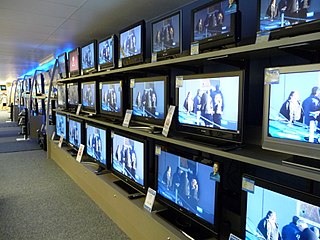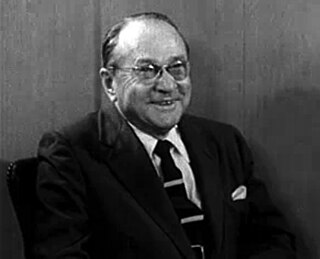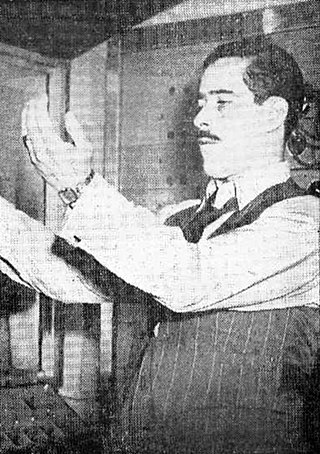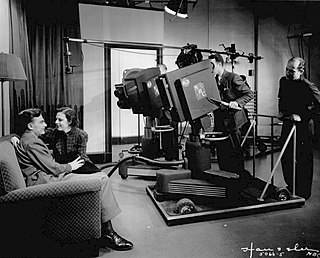
Television (TV) is a telecommunication medium for transmitting moving images and sound. The term can refer to a television set, or the medium of television transmission. Television is a mass medium for advertising, entertainment, news, and sports.

Vladimir Kosma Zworykin was a Russian-American inventor, engineer, and pioneer of television technology. Zworykin invented a television transmitting and receiving system employing cathode ray tubes. He played a role in the practical development of television from the early thirties, including charge storage-type tubes, infrared image tubes and the electron microscope.

It is generally recognized that the first radio transmission was made from a temporary station set up by Guglielmo Marconi in 1895 on the Isle of Wight. This followed on from pioneering work in the field by a number of people including Alessandro Volta, André-Marie Ampère, Georg Ohm and James Clerk Maxwell.

TF1 is a French commercial television network owned by TF1 Group, controlled by the Bouygues conglomerate. TF1's average market share of 24% makes it the most popular domestic network.

NPO 1 is the first national television station in the Netherlands. It launched on 2 October 1951. It provides public broadcasting and currently exists next to sister channels NPO 2 and NPO 3. Several broadcasting organisations of the Publieke Omroep deliver a wide variety of programs for the channel, usually for larger audiences. In 2018, it was the most viewed channel in the Netherlands, reaching a market share of 22.0%.

Outside broadcasting (OB) is the electronic field production (EFP) of television or radio programmes from a mobile remote broadcast television studio. Professional video camera and microphone signals come into the production truck for processing, recording and possibly transmission.

The concept of television is the work of many individuals in the late 19th and early 20th centuries. The first practical transmissions of moving images over a radio system used mechanical rotating perforated disks to scan a scene into a time-varying signal that could be reconstructed at a receiver back into an approximation of the original image. Development of television was interrupted by the Second World War. After the end of the war, all-electronic methods of scanning and displaying images became standard. Several different standards for addition of color to transmitted images were developed with different regions using technically incompatible signal standards. Television broadcasting expanded rapidly after World War II, becoming an important mass medium for advertising, propaganda, and entertainment.

This is a list of when the first publicly announced television broadcasts occurred in the mentioned countries. Non-public field tests and closed circuit demonstrations are not included.
TMF was a 24-hour music channel operated by Viacom International Media Networks in the Netherlands. The channel was previously in every standard TV package, but it ceased operating on 1 September 2011. The channels operations were based in Amsterdam. The channel was previously known as TMF6 and TMF9.

A number of experimental and broadcast pre World War II television systems were tested. The first ones were mechanical based and of very low resolution, sometimes with no sound. Later TV systems were electronic.

Rede Tupi was a Brazilian commercial terrestrial television network. Its flagship station, located in the city of São Paulo, was the first TV station to operate in the country, being inaugurated on 18 September 1950 by journalist Assis Chateaubriand. It was owned by Diários Associados, one of the largest media conglomerates of the 20th century, owner of several newspapers, magazines, and radio stations.

Columbia Workshop was a radio series that aired on the Columbia Broadcasting System from 1936 to 1943, returning in 1946–47.
441-line is the number of scan lines in some early electronic monochrome analog television systems. Systems with this number of lines were used with 25 interlaced frames per second in France from 1937 to 1956, Germany from 1939 to 1943, Italy from 1939 to 1940, as well as by RCA in the United States with 30 interlaced frames per second from 1938 to 1941. Broadcasts were planned in Finland for 1940, but eventually cancelled due to World War II. Some experiments with similar systems were carried out on the USSR in the 1930s and Japan in 1939.
Television in Croatia was first introduced in 1956. As of 2012, there are 10 nationwide and 21 regional DVB-T television channels, and there are more than 30 other channels either produced in the Republic of Croatia or produced for the Croatian market and broadcast via IPTV, cable, or satellite television. The electronic communications market in Croatia is regulated by the Croatian Regulatory Authority for Network Industries (HAKOM), which issues broadcast licenses and monitors the market. The DVB-T and satellite transmission infrastructure is developed and maintained by the state-owned company Odašiljači i veze (OiV).
This is a list of events related to British television in 1938.
Provjereno is a Croatian investigative journalism television news magazine that is broadcast on Nova TV. The show was launched in 2007, and airs Thursdays at 10 pm. It is hosted by Ivana Paradžiković.
The 567-line television system was an experimental late 1940s proposal by Philips of the Netherlands for a European television system, with some test transmissions being made from Eindhoven.
İTÜ TV is the first Turkish television station. The first Turkish television broadcast occurred on July 9, 1952, from a station at Istanbul Technical University's electrical engineering department. Weekly two-hour broadcasts from ITU continued on an experimental basis, but by 1957 there were still fewer than 200 television receivers in Istanbul. ITU broadcasts continued until 1970, and in 1971 ITU's facilities and equipment were ordered to be transferred to the Turkish Radio and Television Corporation, and ITU TV was closed down forever. By 1991, ITU TV was replaced by a new channel called Show TV.

343-line is the number of scan lines in some early electronic monochrome analog television systems. Systems with this number of lines were used with 30 interlaced frames per second the United States by from 1935 to 1938, and with 25 interlaced frames per second in the Soviet Union from 1937 onwards. A similar system was under development in Poland in 1939.
The 455-line standard, also known as 450-line, was a Frenchblack-and-white analog television broadcasting norm employed between 1937 and 1939. It was later replaced by the 441-line format, which remained in use until 1956.










